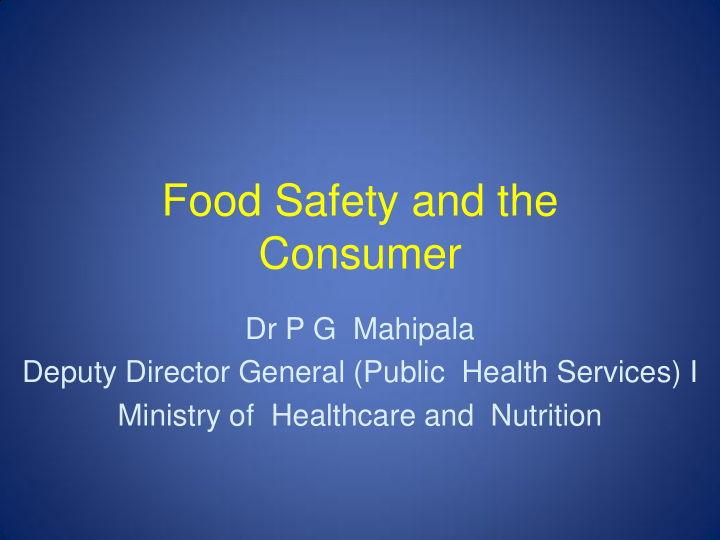



Food Safety and the Consumer Dr P G Mahipala Deputy Director General (Public Health Services) I Ministry of Healthcare and Nutrition
Food : any substance, whether processed, semi processed or raw, which is intended for human consumption ,and includes drink, chewing gum and any substance which has been used in the manufacture preparation or treatment of “food” but does not include cosmetics or tobacco or substances used only as drugs.
What is “food safety” ? Assurance that food will not cause harm to the consumer when it is prepared and/or eaten according to its intended use” ( Codex)
Global situation • Each year 2.1 million people die from diarrhoeal diseases. • Many foodborne diseases occur because of basic errors in preparing meals, whether in restaurants, canteens or homes. • 6000 children die daily from diarrhoeal diseases
Global situation • Epidemiological surveillance has shown an increase in the prevalence of foodborne illnesses – United States - approximately 76 million illnesses, 325,000 hospitalizations, and 5,000 deaths – Australia – 5.4 million cases per annum, 17,770 hospitalizations and 125 deaths One in four people in Australia suffer an incident of foodborne illness annually – China – Estimated 300 million cases per annum
Food safety problems around the world • Advanced technologies • Persistently high incidence of foodborne diseases
Reasons • Biological Bacteria Protozoa Parasites Viruses Fungi and their toxins introduced during food handling
• Chemical Silver residues Pesticides Veterinary drugs - amount to only 0. 5 % of food borne illnesses(in Europe)
Sri Lankan situation Diarrhoeal diseases are the leading causes of hospital admissions (670.7/100,000 pop.) (Annual Health Bulletin 2005)
Diarrhoeal Disease Morbidity, Mortality and CFR, Sri Lanka 1970 - 2002 Rate per 100,000 Pop. Percentage 10000 10 Morbidity Mortality CFR 1000 y t i l a 1 t r o 100 M d Case fatality n a y t 10 i d i 0.1 b r o M 1 0.1 0.01 70 72 74 76 78 80 82 84 86 88 90 92 94 96 98 00 02 Years Source : Epidemiological. Unit
Signs and symptoms of a food borne illness
People at high risk of getting a foodborne illness Infants Pregnant women • Young children & • O lder adults • Persons with chronic diseases
“ Key recommendations ” for food safety The 2005 USDA Dietary Guidelines give five “Key Recommendations” for food safety.
Recommendation 1 : CLEAN
Recommendation 2: SEPARATE
Recommendation 3 : COOK
Recommendation 4 : CHILL
Recommendation 5 : AVOID Raw (unpasteurized) milk or milk products Raw or partially cooked eggs and foods containing raw eggs Raw and undercooked meat and poultry Unpasteurized juices
Food Safety and WTO • Agreement on Sanitary and Phytosanitary Measures - SPS of WTO requires that risk assessment be used in trade dispute • A country is then expected to have an effective program on food safety to be able to demonstrate that the food hazard is properly and effectively controlled- all through the food chain
Food Safety in Sri Lanka • National Food Safety Program
Food Act No 26 of 1980 The Act controls , • Manufacture • Importation • Transport • Sale • Distribution • Advertisement • Labelling of food.
Amendments under this Act Amendments to this Act • Food (Amendment ) Act No. 20 of 1991
Prohibitions in respect of Food • No person shall manufacture, import, sell or distribute any food Injurious to health Unfit for human consumption Unclean, decayed, decomposed., insect infested. Adulterated. Contravention of the provisions of Act / Regulation
Prohibitions on Manufacture, preparation preservation, packaging or storage for sale of food under unsanitary conditions . “ Unsanitary condition” - such conditions or circumstances which may • contaminate food with dust, dirt or filth or render food injurious to health
Prohibitions on Labelling, packaging, advertising • No person shall label, package, treat, process, sell or advertise any food In a manner that is false Misleading Deceptive Likely to create an erroneous impression Regarding its character, value, quality, composition, merit or safety
Administrative Structure of Food Act No 26 of 1980 Hon Minister DGHS Food Advisory Committee DDG (PHS) I D(E & OH) Asst.Director-FCAU
Members of FAC • DGHS Chairman Two members to represent commercial interest • D(E&OH) Secretary Nutritionist • DDG(PHS) Food technologist • Asst. Director-FCAU Expert in Food Science • City Analyst Government Analyst • D G Customs DG SLSI • Representative of Trade & Commerce • Two members to represent of the consumer It shall be the duty of the committee to advise the Minister on matters arising on the administration of this Act. •
Powers of Authorized Officers • Seize & detain any article. • Institute Prosecutions. • Arrest persons who commit offences under the Act (without a warrant)
Authorized Officers • Medical Officer Health • Public Health Inspector
Approved Analyst • The Government Analyst • Additional Approved Analysts City Analyst – Colombo MC City Analyst - Kandy MRI NIHS Lab- Kalutara Anuradapura Lab Kurunegala
Everyone has a responsibility for food safety….
Thank you.
Recommend
More recommend